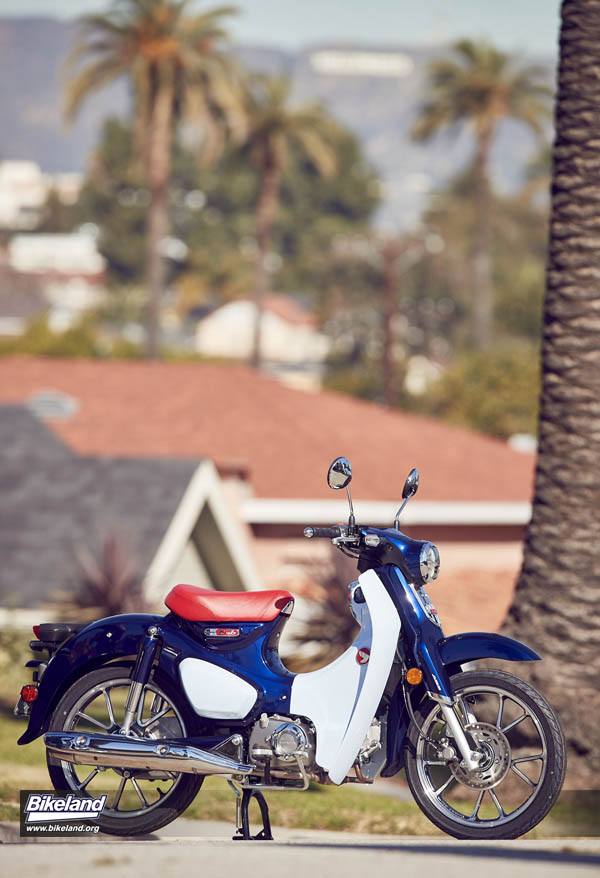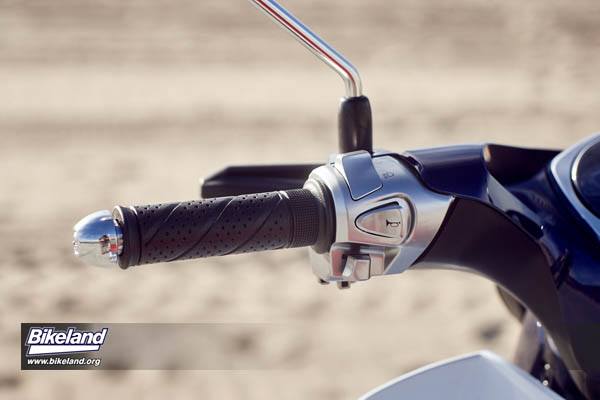
Only thing missing…. the Beach Boys
Photos by Honda, Drew Ruiz, and Jon Row
2019 Honda Super Cub C125 ABS
In the prosperous 1950’s, American cars had big fins and big V-8 engines. Motorcycles were Harley-Davidsons from Milwaukee or British bikes and riders were perceived as cops or hooligans. Hollywood cemented motorcycling’s outlaw image in the Marlon Brando film, “The Wild One”, a fictionalized account of the infamous Hollister, California motorcycle gang “riot.”
How could a 50cc step-thru motorcycle from a small Japanese company change all that?
Introduced in Japan in 1958, the original Super Cub was an instant hit but it actually almost didn’t make it to America. Honda was preparing to enter the US market but believed American buyers would respond better to the company’s larger, more traditional models---bikes more suited to America’s open spaces, open roads and automobile culture. Fortunately, while setting up the initial Los Angeles area headquarters, American Honda’s first employees rode Super Cubs on errands all over Southern California. Wherever the little bikes went, the public reacted enthusiastically.
With this insight (and a lot of guts), Honda decided to import the Super Cub. In addition to selling through established motorcycle shops, Honda let sporting goods stores and bicycle shops become dealers, limited to selling only 50-90cc models. In the stagnant 50,000-unit US market, Honda pitched the Super Cub to people who had never ridden a motorcycle
In American Honda’s first two years Super Cub sales were modest but as the dealer network grew, sales did too. Super Cub models expanded. Electric start was added in 1960 and a trail version in 1961. In 1964 the company decided to take a huge risk with its new “You meet the nicest people on a Honda” tag line and invested $300,000 ($2.4 million in today’s money) for two ninety-second TV commercials on the Academy Awards broadcast. The mid April timing was perfect and eighty percent of America’s TV sets were tuned in. The “Nicest People” theme hit a powerful chord. The next day, motorcycling in America changed forever. Sales exploded. At a starting price of $250, Super Cubs helped drive Honda sales to 268,000 in 1965. Requests for dealerships flowed in. Hollywood stars wanted them. Elvis and Ann Margaret cavorted on Super Cubs. Roy Rogers had a trail version. The Beach Boys sang Honda praise and college campuses were awash with them. Moms who would never let their kids have a motorcycle thought Hondas were all right.

The Super Cub funded Honda’s future, established the brand in Japan then around the world. Globally it’s the best selling motor vehicle of all time. Produced in fourteen factories, for 141 countries, over 100,000,000 have been sold, yet it’s been 35 years since it graced US showrooms.
Is it time for a modern version of the longest running, best-selling motor vehicle on the planet? 2019 marks American Honda’s 60th anniversary. Retro styles are back and cool. There’s new focus on minimizing digital domination of life, getting outside and having fun. It’s a good time for motorcycles and a good opportunity for a modern Super Cub.
The Original Super Cub: What was the Big Idea?

The Super Cub’s unique combination of scooter and motorcycle elements required incredible focus, dedication and creativity to get right. Company founders, Soichiro Honda and Takeo Fujisawa personally directed concept, design and testing. Engine performance, price, ease of use, comfort and reliability all had to reach unprecedented levels. The design also had to be unique and appealing to worldwide cultures.
It was, at the time, the most challenging, all encompassing goals ever set for a two-wheeler. No pressure, right?
Honda clearly hit it out of the park with the Super Cub design. The now-famous step-through frame with flared fenders and integrated leg fairing design has stood the test of time and generations. By some estimates, one of every seven people on earth has ridden one, or, to Honda’s chagrin, a knock off from companies trying to copy it. The enduring design has such value that Honda received an unprecedented 3D patent for it in 2014.
Although global sales expanded continuously, U.S. volume flagged in the last half of the 1960s. By 1974, Honda’s 50-90cc dealers were gone and so was the Super Cub. By 1983, American Honda focused on swoopy scooters and discontinued America’s remaining Super Cub descendant, the C70 Passport. Proof that even the most iconic designs need to keep pace with changing times.
Fast forward to 2019.
The New Super Cub: What changed? What stayed the same?
The 2019 Super Cub’s air-cooled 125cc, SOHC two-valve single cylinder engine is quiet, smooth and torquey. Derived from the Grom, the 9.3:1 compression engine is peppy and capable of 60 mph top speed as it sips from the under seat fuel tank at 100+ MPG.
The four-speed transmission with semi-automatic centrifugal clutch and no clutch lever has a classic heel-toe shifter with neutral-at-bottom pattern making gear changes easy for newbies. Veterans will appreciate the smooth, quiet shifting provided by higher quality internal bearings and dampers. Clicking off up and down shifts with aggressive throttle blips takes a few tries but is great fun when riding amongst shiftless scooter friends.
Honda’s classic pressed steel chassis has new telescopic 26-mm front forks and twin rear shocks. The 3.9” front and 3.3” rear travel is under damped but takes most everything the road gives you in stride. Handling and stability are very good, the 17-inch wheels making a big difference compared to small wheel scooters.
The original wire wheels are replaced by a cast aluminum set that resists flex and allows tubeless tires. A low 30.7” foam solo seat, non-folding foot pegs and original wing-shape handlebars are rubber mounted to reduce vibration.
The 240-pound SC125 stops much better than its ancestors thanks to an anti lock 220mm front disc brake, which performed confidently on both wet and sand covered pavement. Overall fit and finish is highly refined right down to brake pedal detailing.
Lighting is full LED, well integrated and reminiscent of original Cub shapes. A cool neo retro analog/speedo face includes a digital gear indicator and six-segment fuel level display. Ignition “keys” are “smart” E-Fobs. Fobs aren’t our fave, but they allow the seat to unlock remotely and provide access to the small side storage box, fuel cap and, optimistically, two helmet holders. Giving rides to the Nicest People you meet will require some effort though. Honda offers an optional luggage rack but no passenger seat. The frame is ready for passenger pegs so an aftermarket pillion perch can suffice.
Taking a Nostalgic Spin

Honda organized an all-day ride for journalists around the Los Angeles area. Departing from American Honda’s original Pico Boulevard office, we enjoyed admiring looks and public reactions those first Honda employees found so familiar. Boomers, Gen X and Millennials all gave our Super Cub entourage smiles and thumbs up. After riding the 2019 C125 Mr. Honda would undoubtedly be smiling too.

The 2019 Honda Super Cub C125 comes in original light blue with a red seat honoring Mr. Honda’s love of crimson cars and clothes.
Want to experience the latest version of the motorcycle that changed the world? The new Super Cub will hit showroom floors this Spring in limited quantities, so don’t delay.
• Color: Pearl Niltava Blue
• MSRP: $3,599
• Availability: March 2019
• More at:
https://powersports.honda.com/2019/super-cub-c125-abs.aspx
Specs
ENGINE
Engine Type: 124.9cc air-cooled single-cylinder four-stroke
Bore And Stroke: 52.4mm x 57.9mm
Compression Ratio: 9.3:1
Induction: PGM-FI with automatic enrichment
Ignition: Fully transistorized
Valve Train: SOHC; two valves per cylinder
DRIVE TRAIN
Transmission: Four-speed semi-automatic
Final Drive: Chain
Clutch: Automatic centrifugal
CHASSIS / SUSPENSION / BRAKES
Front Suspension: 26mm telescopic fork; 3.5 inches travel
Rear Suspension: Twin shock; 3.6 inches travel
Front Brake: Single 220mm hydraulic disc; ABS
Rear Brake: Mechanical drum
Front Tire: 70/90-17
Rear Tire: 80/90-17
DIMENSIONS
Rake: 26.5°
Trail: 2.8 inches
Wheelbase: 48.9 inches
Seat Height: 30.7 inches
Fuel Capacity: 1.0 gallon
Curb Weight: 240 pounds (Includes all standard equipment, required fluids and full tank of fuel—ready to ride)
OTHER
Emissions: Meets current EPA standards. Models sold in California meet current CARB standards and may differ slightly due to emissions equipment.
Available Colors: Pearl Niltava Blue
FACTORY WARRANTY INFORMATION
One Year: Unlimited-mileage limited warranty; extended coverage available with a Honda Protection Plan.

Reborn under a sign… one that helped launch it

Front disc with ABS works well.
















The C70 Passport feels archaic after riding the new Super Cub.

Honda’s American birth place. Now an acupuncture clinic and pot dispensary. They frequently get helmeted visitors wanting “To see where it all began”

How Elvis left the building.

Over 100 Million sold since 1958. Number two? Toyota’s 45 million Corolla’s since 1966